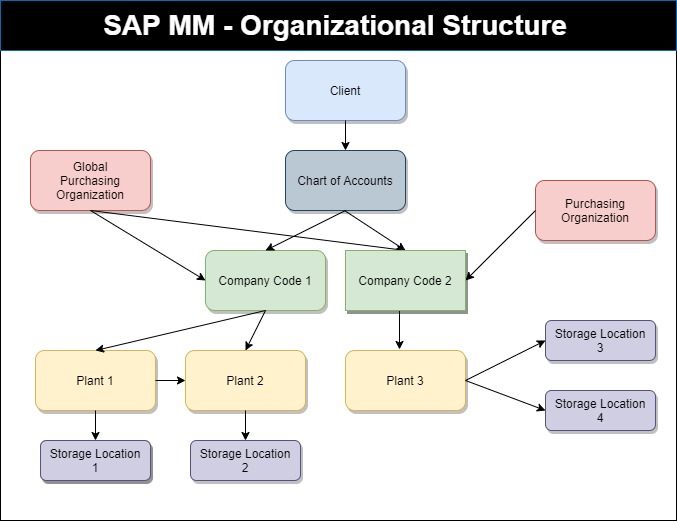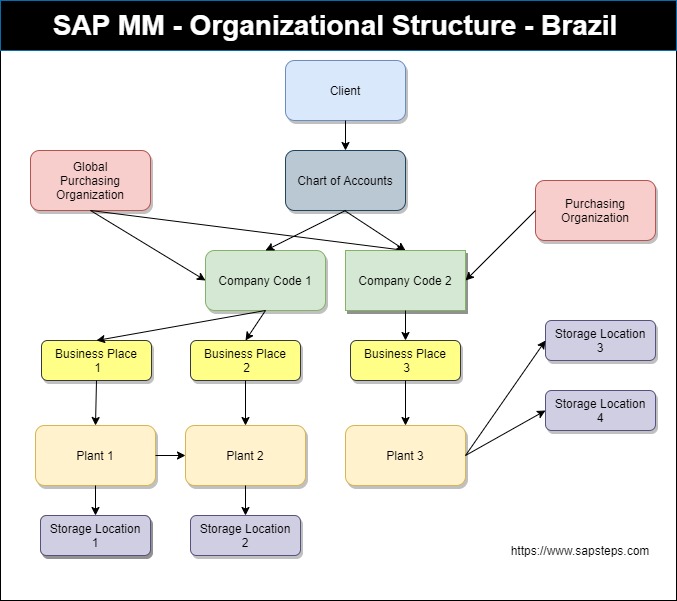Introduction
One of the first definitions that are necessary for any implementation of the SAP system in a company is the definition of its organizational structure.
Before thinking about how the structure will be within SAP itself, the company’s business team (financial, fiscal, logistical, etc.) must have defined exactly what the company’s structure is so that the project team can use the “ design ”of the structure and make the necessary configurations within SAP.
There is no standard for this type of activity.
The definition of the structure depends entirely on how the company in question is organized.
The company can be a distributor and have several distribution centers or just an importer that buys the products and resells them directly to third party distributors, it can be a factory or it can be simply a single building and its main source of income is the sale of services.
The scenario varies widely.
In this post, we will detail the organizational structure (focusing on MM) and in the end, we will add an organizational unit that is exclusive to Brazil within SAP.
Organizational Structure MM
Below, we can see the standard organization structure within the MM module:

Client
The Client is not a standard MM module structure. A client can be understood with the whole environment in which we can have countless companies in operation.
Chart of Accounts(COA)
It is a structure of the SAP finance module, but due to its great importance and its total integration with MM, it is present in our structure.
Within the Chart of Accounts, we find all accounts to be used for accounting for the processes of purchases, sales, inventory, etc.
We can have a Chart of Accounts per company or we can use it for more than one company.
Company Code
It is a structure that represents a legal entity, that is, the company is the place where the respective company tax code will be configured (for Brazil there is an additional point that we will deal with below).
It is also a structure present within the finance module (FI), but it is extremely important for the MM module.
For example:
- One of the vendor master views is by company code, that is, if we use the same supplier for different companies in the group, we can (and should) have a single supplier code, with different information for it.
- When creating any purchase order, the company code is a piece of mandatory information, and can even be used to create a purchase order release strategy.
Plant
Finally, we come to an organizational unit where the MM module is responsible.
A plant represents a company’s logistics or manufacturing unit.
It is at this level that we perform:
- Material purchases
- Service Purchases
- Material planning
- Production of materials
- Inventory
- Etc
Inventory control at the plant level is done only at the quantity and value level.
Storage Location
The Storage Location is used to differentiate the type of stock being stored at a specific physical area.
It is also used for carrying out inventory movements within the system and for inventory control.
For example, it is common to have the following types of storage location:
- Raw Materials
- Packaging
- Finished Material
- Scrapping
- Etc
We can have several associated Storage Locations for the same plant.
Inventory control at the storage location level is done only at the quantity level.
Purchasing Organization
Another important organizational unit within the MM module is the Purchasing Organization.
It is responsible for negotiating terms of purchases from suppliers.
In some companies, we may have a purchasing organization for all global purchases (for example: when a multinational company purchases laptops for all offices around the world at once, to negotiate better prices), or they may be local (negotiations for contracts referring only to that company code).
In my experience, it is very common to have two Purchasing Organizations as described, just for the division of global and local negotiations.
Brazil Localization
Of course, for Brazil, it would have to be different.
In addition to what we have just seen, there is Brazilian legislation that ended up forcing SAP to create a new specific organizational unit for all Brazilian companies:

This new organizational unit is called Business Place.
Unlike most countries, where the company’s fiscal configuration is an activity of the finance module (FI) consultant, in Brazil, this is a divided activity between FI, SD, and MM.
It is divided precisely by the fiscal need.
Within the Company Code, the first 8 digits of the Brazilian federal tax code (CNPJ) are configured.
And for each plant associated with that company, a Business Place must be created and associated.
Business Place will be responsible for storing the second part of the federal tax code (4 digits).
Also, several configurations referring to Nota Fiscal (Brazilian Invoice) are performed directly through the Business Place.
Conclusion
I hope you enjoyed learning a little about the MM organizational structure within SAP.
In the future, we will publish a drawing of the complete organizational structure, with the integration of all modules (FI, CO, MM, SD, WM).
If you liked this post, be sure to subscribe to our newsletter to receive first hand the next posts and share this post with your friends.
If you have any suggestions (including subjects you would like to read about), feel free to send an email to sapsteps@sapsteps.com.
A big hug,
Bruno César



